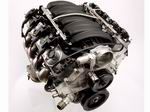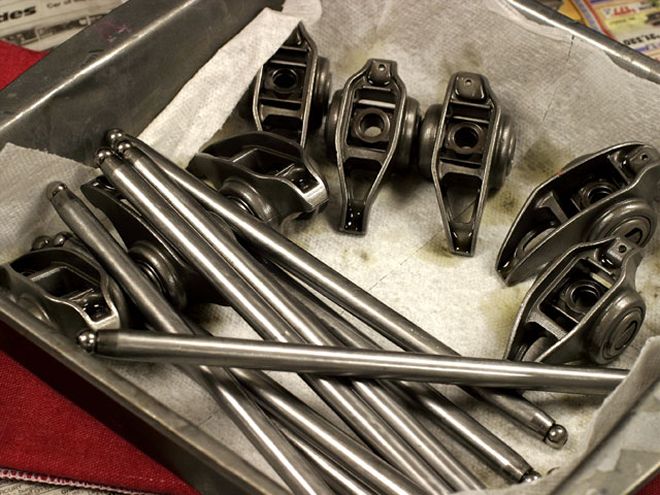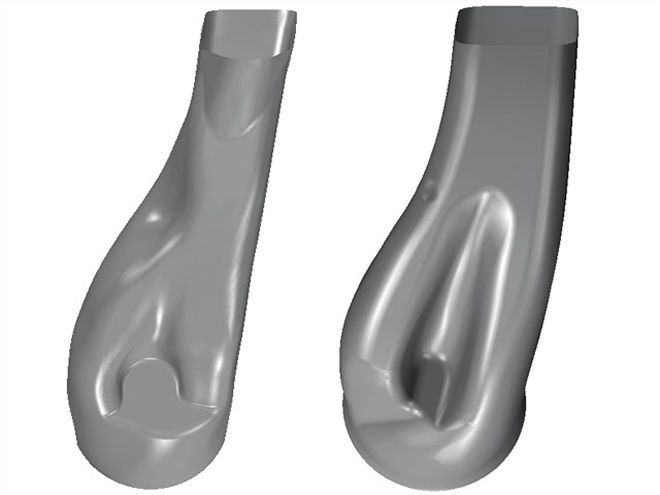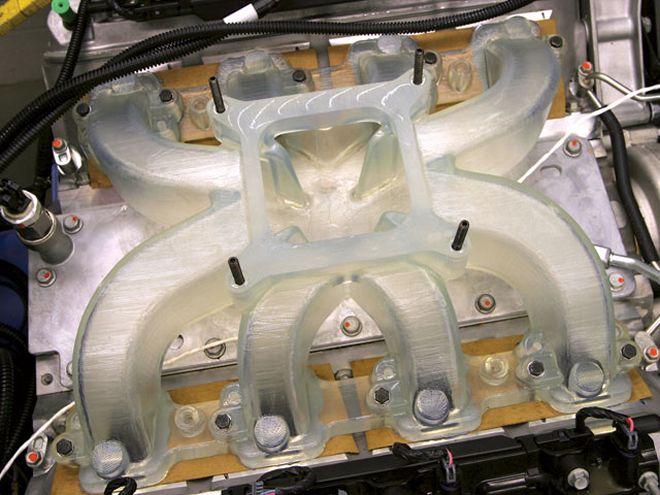
When General Motors revealed the '06 Corvette Z06's 505hp LS7 V-8 enginelast year, our first question was, "How detuned is it?" After all,despite its 500-plus horses, the latest and greatest 7.0L small-blockonly makes 1.18 hp from each of its 427 ci, which seems tame for anengine with massive CNC-ported cylinder heads and 11.0:1 compressionthat spins to seven grand.
But let's give it a break and take a closer look at that power rating.Modern factory engines are built to pass mind-boggling durabilitystandards that few race engines and virtually no backyard-built hot-rodmills could ever hope to pass. For example, GM's standard durabilitytest consists of nearly 300 hours of operation at wide-open throttle,with the engine cycling back and forth between peak horsepower andtorque under maximum load. The LS7 also has to pass a thermal shock testthat flushes engine coolant ranging from about 250 degrees F to -40degrees F through the block while it's running. Even in the elite,low-volume Corvette Z06, the LS7 must be serviceable, warrantable, andtame enough to power your boss' secretary's daily driver.
One other important factor accounts for its seemingly tame rating aswell. The 505hp rating is generated under SAE J-1349 testing conditions,which correct measured power output to more real-world temperature andatmospheric pressure conditions than the familiar Standard Temperatureand Pressure factor used by racers and magazines that corrects to agenerous 60 degrees F and denser air conditions. SAE numbers aregenerally about 5 percent lower than STP. Indeed, the tests we conductedwith an as-delivered GMPP LS7 crate engine on a Super Flow 901 dyno atThompson Racing Engines in Redford, Michigan, generated 546 hp at 6,100rpm and 514 lb-ft of torque at 4,900 rpm with stock LS7 manifolds butwithout catalytic converters or stock mufflers and exhaust using the STPfactor. That translates to 522 hp and 492 lb-ft using the SAE factor. Soin "magazine numbers," the LS7 is really making 1.27 hp/ci, which isdecent for a mildly cammed pump-gas engine. And as you'll see, with morecam and better headers, it gets a whole lot more decent.
The LS7 shares the same basic architecture of the latest Gen IViterations of the small-block, but it's pumped up with a 4.125-inch boreand a 4.00-inch stroke. Major deviations from the base C6 Corvette's6.0L LS2 include a revised valve angle of 12 degrees compared to 15degrees for the rest of the Gen III/IV family, offset intake valvelocation and rockers arms, pedestal-mount roller-rockers arms replacingthe standard Gen III/IV stand-mounted rockers, and completely revisedintake- and exhaust-port shape and location. The LS7 cylinder headsfeature fully CNC-ported high-flow cylinder heads (see Flow Chart) withraised intake ports that replace the familiar LS1/LS2 "cathedral" ports.The redesign to a more traditional race-style rectangular-port designwas made possible by the offset-intake-valve pushrods. To achieve theLS7's 7,000-rpm redline, the highest ever for a production pushrod V-8,lightweight titanium intake and sodium-filled exhaust valves are used,along with ovate-wire conical beehive-style valvesprings. Forgedtitanium connecting rods for lighter reciprocating mass swinging from aforged crankshaft ensure long-term high-rpm durability, and oil controlunder sustained high lateral acceleration loads is maintained by asemidry-sump oiling system. Taken as a whole, the LS7 is an impressivepackage for a mass-production factory engine. And to top it off,production Z06 Corvettes routinely achieve 25-plus miles-per-gallon fueleconomy with reports of as high as 30 mpg under sustained highwaycruising.
When GM Performance Parts announced it would release the LS7 as alimited-edition crate engine, we saw our chance to get an answer to ourinitial reaction. Although availability will be limited (fewer than 150will be sold through select GMPP dealers) and the $16,795 list price (asof press time) isn't cheap, we got dibs on one of the first and lined upsome key help from within GM to see what an LS7 can do when releasedfrom the confines of a Z06's engine compartment. Through connections atGM Powertrain, we spent an afternoon touring the airflow researchlaboratory at the GM Technical Center and interviewing several of thekey engineers responsible for the development of the valvetrain andcylinder heads. Through those same hookups we got the exclusive insidescoop on the development of a pair of GM Performance Parts HOT cams thatare scheduled for catalog release by the time you read this (see CamSpecs chart). Along the lines of GMPP's famous HOT cam for the Gen IILT4 engines, these latest versions are designed to work with stockvalvesprings and piston-valve reliefs, so the swap is a simple,line-up-the-dots affair, at least with the smaller of the two. Thelarger Stage 3 cam, which increases peak valve lift to 0.630 inch,requires swapping a different set of valvespring retainers to increasethe spring's installed height. The change is necessary to avoid coilbind with the higher lift, but the reduced mass of the replacementtitanium retainers results in improved high-rpm valve control, accordingto GM Powertrain engineer Tony Roma, who arranged the testing of thecams.
Combined with a pair of 13/4-to-17/8-inch step headers, the Stage 3 cammade exactly 600 hp at 6,800 rpm and 526 lb-ft of torque at 4,800 rpm,or 1.40 hp/ci with the SAE correction factor at Katech EngineDevelopment. That's a 90hp gain over the stock cam with the sameheaders, and it's a damn good answer to our question.
 The LS7's roller fulcrum rocker arms are similar in design to thoseused on previous Gen III and IV small-blocks, but the intake rockers areoffset by 7 mm to provide increased port clearance around the pushrod.They also bolt directly to cast-in bosses in the heads rather than to aseparate bolt-on stand as is used on other Gen III/IV engines. Also notethe beefy stock 3/8-inch pushrods that are used to ensure maximumvalvetrain stiffness. That used to be big-block stuff!
The LS7's roller fulcrum rocker arms are similar in design to thoseused on previous Gen III and IV small-blocks, but the intake rockers areoffset by 7 mm to provide increased port clearance around the pushrod.They also bolt directly to cast-in bosses in the heads rather than to aseparate bolt-on stand as is used on other Gen III/IV engines. Also notethe beefy stock 3/8-inch pushrods that are used to ensure maximumvalvetrain stiffness. That used to be big-block stuff!
Flow Chart
The following cylinder head flow data comparing the LS7, LS6, and LS1heads was provided by GM Powertrain from data generated in its airflowresearch lab at the Warren Technical Center. These tests were conductedon a flowbench pulling 7 kpa depression drop, which is equivalent to theconventional 28 inches of water depression, but the flow numbers arerecorded in the metric measurement of grams of air per second. Althoughthere isn't a simple conversion factor to convert grams per second intocubic feet per minute, the charts nonetheless provide an excellentcomparison of these heads' flow characteristics in relation to oneanother. The most impressive thing to note is that the LS7's exhaustport flows more peak air than the LS6's intake port. To put the LS7'speak intake flow into context, on a Superflow 600 flowbench, it flowsabout 360 cfm at 0.600-inch lift, which is 15.25 mm.
Exhaust Port AirFlow (grams/sec)
Intake Port AirFlow (grams/sec)
 By replacing the standard Gen III/IV bolt-on rocker-arm stands withpedestals cast directly into the head, GM cylinder head designers wereable to remove the large divot in the top of the intake ports created bythe boss for the rocker-stand holddown bolts. The redesign also allowedthe intake-port roof to be raised to straighten the air-charge path fromthe manifold into the cylinder.
By replacing the standard Gen III/IV bolt-on rocker-arm stands withpedestals cast directly into the head, GM cylinder head designers wereable to remove the large divot in the top of the intake ports created bythe boss for the rocker-stand holddown bolts. The redesign also allowedthe intake-port roof to be raised to straighten the air-charge path fromthe manifold into the cylinder.
 Despite its delicate appearance, the clear-resin stereo lithography intake manifold proved very tough on the dyno, shrugging off a couple of wicked backfires from a computer-related timing glitch. We've been told that similar manifolds have even passed 24-hour in-car durability tests
Despite its delicate appearance, the clear-resin stereo lithography intake manifold proved very tough on the dyno, shrugging off a couple of wicked backfires from a computer-related timing glitch. We've been told that similar manifolds have even passed 24-hour in-car durability tests
A Carbureted LS7
The very cool photo on this month's cover is of a stereo lithographyprototype carbureted intake manifold that GM Racing developed for theLS7 crate engine. Although GM Racing asked us not to quote specificpower numbers, the results of the testing with the open-plenumsingle-plane carbureted intake manifold running a 1,050-cfm Race DemonRS 4150-style carburetor were near-perfect overlays of the EFImanifold's horsepower and torque curves. This manifold is also expectedto fit the soon-to-be-released L92 6.2L small-block's cylinder heads,which share the LS7 head's raised rectangular-port location and offsetintake valves but retain the standard Gen III/IV 15-degree valve angles,which makes them a very attractive alternative to the LS7 heads for4.00-inch and smaller bore engines. The cast-aluminum production versionof this manifold should be available now through GMPP dealers.
Stock LS7 Cam
Rocker ratio: 1.8:1
Intake lift (at valve): 0.593 inch
Exhaust Lift (at valve): 0.588 inch
Gross Cam Timing (degrees)
Timing at 0.050-inch lift (degrees)
Dyno Results
Stock Cam with 13/4-inch to 17/8-inch x 17-inch primary header to2.5-inch merge collector
Stage 2 Cam
Rocker ratio: 1.8:1 Intake lift (atvalve): 0.583 inch Exhaust lift(at valve):0.583 inch
Gross Cam Timing (degrees)
Timing at 0.050-inch lift (degrees)
Dyno Results
Stage 2 Cam with 13/4-inch to 17/8-inch x 17-inch primary header,2.5-inch merge collector
Stage 3 Cam
Rocker ratio: 1.8:1 Intake lift (atvalve): 0.630 inch Exhaust Lift (at valve):0.630 inch
Gross Cam Timing (degrees)
Timing at 0.050-inch lift (degrees)
Dyno Results
Stage 3 Cam with 13/4-inch x 26-inch primary header with 2.5-inch mergecollector